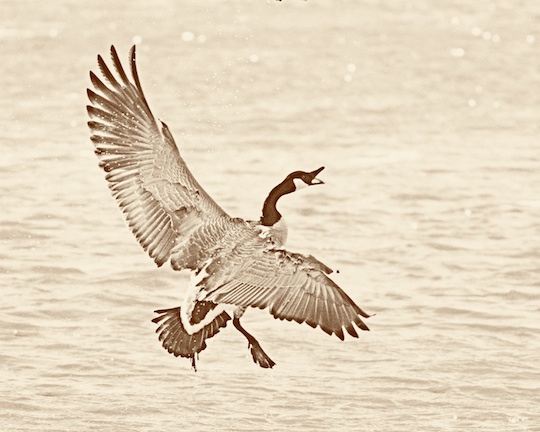
I don't think that should automatically be the next choice - at least not yet! If the image has some character, let's get creative and try to save it! Take a look at your image editor of choice (or plug-ins that work with it) and see what filters are available - just start playing around with the options - try black and white and go from there - see what happens! (remember, you were probably ready to trash the shot - so it's not like you going to ruin it or anything!)
The shot above was almost completely "bad lemons" (blown highlights and out of sharp focus) but it had some character to it These fellows were having a gentleman's disagreement over a lady and the goose on the left seemed to be yelling directly in the the other chaps ear.
From the Imperfect Photographer's Dictionary . . .
Bad lemons: all the sugar in the cupboard won't make these images sweet! A really bad lemon usually has three or more critical flaws (the geese above have two) or a particular flaw is exceptionally bad. For example, if the focus was so terrible that you couldn't identify the critters as water fowl, that would probably qualify!
This image was too cute, I had to do something to save it. My personal choice in filters is Nik Color Efex Pro and the primary effect in the goose image is an effect called "Glamour Glow". Now it's still not a great image - but I like the personality it has! If an image is technically perfect, but boring, there's not much you can do - but an interesting image will give you some latitude and allow some imperfections to be overlooked.
Give it a try the next time you end up with lemons, make some lemonade. Checkout my "lemonade" gallery, I decided to get my own collection together!
I've included some links to a few good creative filter packages, check out the trials and see what you think!

 Photo books are a dime a dozen, and most rehash all the same stuff over and over again - but E.J. Peiker's book is different, it's targeted specifically at one subject - ducks. The book does cover all the standard fare topics (equipment, exposure, light, technique . . . and so on) but every subject is directed back to the book's main focus - how it relates to ducks! The section on field techniques is very detailed and was found to be a strong benefit to enhancing my outdoor acumen - espeically the section on
Photo books are a dime a dozen, and most rehash all the same stuff over and over again - but E.J. Peiker's book is different, it's targeted specifically at one subject - ducks. The book does cover all the standard fare topics (equipment, exposure, light, technique . . . and so on) but every subject is directed back to the book's main focus - how it relates to ducks! The section on field techniques is very detailed and was found to be a strong benefit to enhancing my outdoor acumen - espeically the section on 


